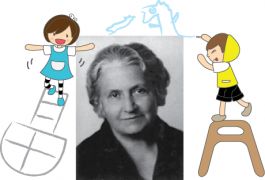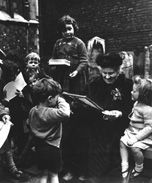| 澳門蒙特梭利教育中心 | Macao Montessori Center |
What is the Montessori Method?
Based on her research and experiments with young children, Italian physician turned educator Dr. Maria Montessori (1870-1952) developed a holistic education system, and a series of teaching materials to help children to grow and learn at their own pace. This system also helps adults to guide and assist their children in the development process.
The Montessori Method combines elements of medical science, psychology, embryology, anthropology and philosophy. The method aims to bring about, sustain and support children's true natural way of being in an environment prepared with materials designed for their self-directed learning activity. The Montessori Method is used in schools, while trained parents can also apply the method at home.
Maria Montessori has once said modestly: “I did not invent the Montessori Method, I just paid more effort in studying children”. However, her books about children's education have been translated into 37 languages and its impact on the reform and development of children's education today is undeniable. Dr. Montessori devoted herself to promoting education and she believed children are the greatest hope for the future. During World War II, the Montessori Method of teaching was thought of as an activity that promoted world peace, and led to her nomination for the Nobel Peace Prize 3 times.
The Montessori Method has been greatly influential on the education systems in Europe, the United States, Canada, China, Taiwan and Japan for decades, and in recent years, it has also been introduced to Hong Kong and Macao. More and more parents know about Montessori and more Montessori kindergartens and schools have been established. Even shops started to sell "Montessori teaching materials & toys”. However, parents should remember that all Montessori materials must be manipulated correctly and only trained adults who truly understand the Montessori Method can make the best use of the materials.
What make the Montessori Method so different?
From scientific observations and experiments, Maria Montessori found that each child has the ability to learn on his or her own and strive for perfection. This made her look at children differently, and adopted a new and revolutionary approach to dealing with children. The Montessori Method has several attributes which made it so different from traditional teaching methods:
1. Child-centered
In a Montessori classroom, children are recognized as individuals who are different from adults and children are the centre instead of the teacher. All activities are designed from the children's points of view.
2. Self-directed learning
Children under the age of 6 do not have enough cognitive ability for education using merely words. The Montessori Method does not recommend teacher-centered education. Instead, Dr. Montessori suggested us to follow the children's inner guidance for self-directed learning in everyday lives, supported by a well prepared learning environment and a comprehensive range of teaching materials.
3. Grasp children's sensitive periods
Children aged 0 to 6 will have particular preferences during different periods of time. For example, each child will have periods when they are especially attracted to numbers, alphabets, senses, order and so on. If we can seize these sensitive periods and provide the children with appropriate learning opportunities, they can get the best result from learning.
4. Teacher's role: to support and to inspire
The principal role of Montessori teachers is to understand the internal needs of children and prepare the learning environment accordingly. Teachers also demonstrate the proper manipulation of teaching materials. Teachers observe each child and give instant assistance to him/her according to his/her individual needs. Teachers do not compare the children and respect their own developmental pace and preferences. Children are being loved and respected in the Montessori classroom, and this harmonious environment will then eventually foster their passion for learning.
5. Focus on wisdom and personality
The essence of early childhood education is to help children grow up happily. Maria Montessori emphasized that early childhood education is not only to prepare for schooling, but to foster the children's wisdom, personality and virtue of life-long learning ability.
6. Respect children's planes of development
There is no strict curriculum in a Montessori classroom. Children pick up teaching materials at their own free choice and thus they will work with great interest and concentration. By repeating the work, the child's perseverance and patience can be formulated.
7. Mixed-age class
Montessori classrooms consist of mixed-age groups, such as 0 to 3, 3 to 6. Children interact with each other and learn from each other in a spontaneous manner. They can then develop brotherhood/sisterhood and good social behaviors.
8. A wide range of teaching materials
There are about 400 Montessori teaching materials. The teaching materials are not for teachers to “teach” children but for children to manipulate and work with. The teaching materials, being at different levels of difficulty, aim to stimulate children to manipulate them repetitively and achieve self-directed learning eventually.
9. Remarkable result
In the Montessori classroom, children are trained to learn by themselves in a step by step manner. In short term, their learning result may be indistinctive, but when it comes, you will be very pleasantly surprised.
What will your child learn in a Montessori Classroom?
Montessori found that children have the gift to self-learn in order to enhance their wisdom. The Montessori classroom is equipped with a wide range of teaching materials to facilitate their self-directed learning.
The Montessori classroom is a prepared environment established by adults, so that children are allowed to explore and work on beneficial activities according to their creativity. Trained teachers, who adhere to Dr Montessori's spirit of “love and respect the child”, observe the children and guide them towards independence according to the child's own needs and abilities. In such a carefully prepared environment, children are free to learn by themselves, recognize and correct their own mistakes.
In a Montessori classroom, the teacher demonstrates to children how to manipulate the materials, and then the children repeat the procedures by themselves. By repeating the activities and under the teacher's guidance, children are able to learn the following:
1. Practical life skills
Practical life materials and exercises respond to young children's natural interests in developing acceptable social behaviors, care of self and care of the environment. The primary goal of practical life activities is to promote children's fine and gross motor coordination, while allowing them to adapt to the environment and move towards independence. The secondary goal is to promote the children's perseverance and concentration, while encouraging them to love their fellows and the environment.
2. Sensorial refinement
Human wisdom derived from our senses. Montessori saw the importance of senses in the development of wisdom. She then designed a range of sensorial materials aiming to refine children senses, which can eventually develop their observation, comparison and analytical skills. Montessori emphasized that we can best learn using all five senses (tactile, baric, thermic, auditory and stereognostic). Sensorial education also included music enrichment.
3. Mathematics
Due to its “abstract” attributes, many people perceive Mathematics as being “difficult”. Montessori believed that Mathematics should start from sensorial activities, which allows abstract numeric concepts to be presented to children in a concrete way. Through observation, analysis, concentration and a sense of order, together with repeated manipulation of Mathematics materials, the child will come to understand abstract numeric symbols at ease. Finally, they will come to love Mathematics.
4. Language
Children will come across their sensitive period of language during their first 6 years. Adults can expand the children's vocabularies by speaking precisely and clearly. Montessori teachers always train children's auditory ability and language skills with clear pronunciations and random teaching opportunities.
Although writing skill among children might emerge as late as 5 years old, Montessori's practical life activities (promoting eye-hand coordination) and sensorial activities (refining auditory, tactile and visual senses) have provided solid foundation for reading and writing. Montessori's unique language materials such as the metal insets, sandpaper letters, picture cards can greatly enhance children's writing and reading ability.
5. Culture and Science
The Montessori classroom includes materials and resources to learn culture and science, such as geography, botany, geology, history, astronomy and art. This aims to promote the children's world view and cosmology, and assists them to adapt happily to their environment.

